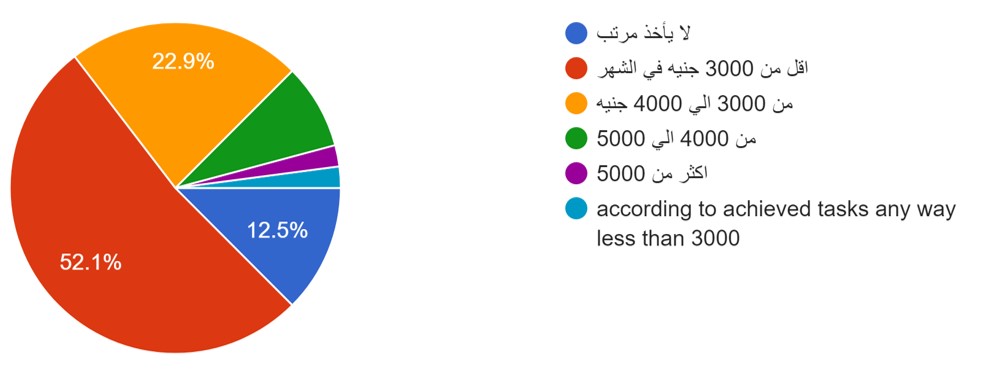- تم الأستقصاء على الخبرات المختلفة لوظيفة المبرمج، وفي اعتقادي فإن معظم مرتبات بقية فريق العمل تتمحور حول المبرمج، اي انه يمكن ان تنسب مرتب اي وظيفة في فريق العمل الي نسبة من مرتب مبرمج مناظر له في الخبرة المهنية او في الأهمية الوظيفية (هذا اعتقاد مبني عن خبرة وظيفية شخصية وليس عن علم مدروس)
- تم تقسيم وظيفة المبرمج الي الدرجات التالية … بالطبع المسميات تختلف من شركة الي اخرى
- مبرمج Entry level … وهو المبرمج حديث التخرج، لديه علم بلغة البرمجة المطلوبة لكن ليس لديه اي خبرة. في العادة يستغرق هذا المبرمج بين شهر الي 6 اشهر حتى يكون منتجا … والمدة تعتمد على درجة تعقيد المشاريع التي يعمل فيها وعلى استعداده للتعلم بسرعة
- مبرمج Junior developer … وهو المبرمج الذي تجاوز المرحلة السابقة واصبح قادرا على تحمل مسؤولية مجموعة من المهام واصبح منتجا
- مبرمج Junior plus … وهو المبرمج الذي اصبح لديه خبرة من سنة الي سنتين، وهناك تقدم ملحوظ في مستوى انتاجيته وتحمله لمسؤولية المهام الموكلة اليه
- مبرمج Senior … وهو المبرمج الذي تجاوز على الأقل اربع سنوات خبرة (وفقا لانطباعاتي عن السوق المصري … مصطلح senior في السوق الأمريكي قد يعني 10 سنوات خبرة على الأقل) … ولديه حد ادنى من الخبرة الأدارية التي تمكنه من ادارة او دعم عدد 2 مبرمجين juniors تحت ادارته
- مبرمج senior plus … وهو المبرمج الذي تجاوز على الأقل 6 او 7 سنوات خبرة… وقادر على ادارة فريق برمجي صغير من 5 مبرمجين مثلا ، ولديه مهارات ادارية جيدة جدا
- مبرمج team leader … وهو المبرمج الذي تجاوز على الأقل 10 سنوات ، قادر على ادارة فريق الشركة فنيا، ووفقا لحجم الشركة وحجم فريقها فقد يكون هو المدير الفني CTO او من يرسم سياساتها الفنية والتقنية … ولديه مهارات ادارية متقدمة جدا
- تم وضع الأستقصاء على جروب خاص على الفيس بوك يضم اغلب الشركات المصرية المسجلة في قاعدة بيانات هيئة تنمية صناعة تكنولوجيات المعلومات المصرية … هذا الجروب يضم في اغلبه الشركات متناهية الصغر والصغيرة والمتوسطة وقليل جدا من الشركات الكبيرة … لذلك فأغلب المشاركين في الأستقصاء من اصحاب الشركات في السوق المصري.
- تم تعمد عدم وضع الأستقصاء على مجموعات (جروبات) المبرمجين على الفيس بوك حتى لايشارك في الأستقصاء الا صاحب عمل
- المرتبات في مصر متباينة جدا بشكل عام وفي قطاع البرمجيات بشكل خاص للأسباب الآتية (في نظري)
- التقلبات السياسية من 2011 والي الآن
- تحرير سعر صرف الدولار مقابل الجنيه (تعويم الجنيه) ، الأمر الذي اثر في معدلات التضخم بشكل كبير. كنتيجة لهذا، هناك شركات استطاعت ان ترفع مرتبات موظفيها بنسب مختلفة وهناك شركات لم تنجح في ذلك … وهو كان احد اهم الأسباب في تفاوت متوسطات المرتبات
- هناك مبرمجين يعملون مع شركات اجنبية (امريكية او اوروبية) بمرتبات بالدولار، وفي معظم الأحيان تكون مرتباتهم احيانا ضعف او ثلاث اضعاف اعلى متوسط للمرتبات في الشركات المصرية
- هناك شركات من دول خليجية فتحت مكاتب لها في مصر وتعطي مرتبات اعلى من المتوسط بقليل
الأستقصاء -كما ذكرنا- تم حصره في الشركات المصرية الصغيرة والمتوسطة وهي المتواجدة على جروب الفيس بوك المذكور اعلاه
- انا لست خبير موارد بشرية ولم ادرس هذا العلم ولكني محتك به، لذلك ان كان من خطأ في طريقة كتابة الأستبيان فلتسامحونا فيه.
- شارك في الاستقصاء 49 شركة
- سعر الدولار حين اجراء الأستقصاء كان 17.8 جنيه مصري
- لم اشارك في الاستقصاء بصوتي
اولا: مبرمج ال Entry level …

اكثر من نصف المشاركين ذكروا مرتب اقل من 3000 جنيه مصري في الشهر اي اقل من 170$ تقريبا. والربع تقريبا اشاروا الي اجر اعلى من 3000 جنيه مصري، وهناك نسبة معتبرة 12.5% لاتعطي راتب لمن هم تحت التدريب
ثانيا: المبرمج ال Junior

اكثر من ثلثي النتائج تقريبا (اللون الأحمر والأزرق مجتمعين) تشير لمرتب من 3000 الي 4000 جنيه مصري. وهناك نسبة مؤثرة تشير الي انه قد يصل الي 5000 جنيه اي مايعادل بحد اقصى 280$ امريكي
ثالثا: المبرمج الــ Junior plus

قرابة النصف تقريبا تشير لمرتب من 5000 الي 6000 جنيه او 340$ تقريبا بحد اقصى … مع تفاوت ملحوظ في المرتب قد يتجاوز الــ 8000 جنيه مصري
رابعا: المبرمج الــ senior

ثلث النتائج تقريبا تشير الي مرتب من 7000 الي 8000، اي حوالي 450$ شهريا … مع تفاوت ملحوظ قد يتجاوز الــ 10000جنيه مصري
خامسا: المبرمج senior plus

قرابة الثلث تشير الي 12000 جنيه بحد اقصى اي 670$ تقريبا، مع تفاوت ملحوظ الي اعلى من 15000 جنيه
سادسا: الـــ team leader

هناك تفاوت واضح في هذه الشريحة بدءا من 15000 جنيه مصري اي حوالي 840$ الي اعلى من 21000 اي 1180$











